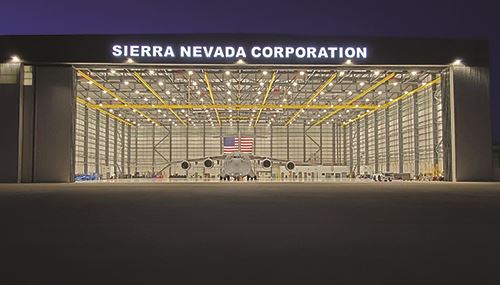At Dayton International Airport (DAY) in Ohio, Sierra Nevada Corporation recently opened a large facility that will be home base for about 140 employees. That 90,000-square-foot hangar and 7,940-square-foot office complex is just the beginning.
In addition to moving people and products around the world, the aviation industry puts people to work. From pilots flying planes to airport staff scanning boarding passes and bags for the next departure, countless lives and livelihoods are involved every step of the way.
 At Dayton International Airport (DAY) in Ohio, Sierra Nevada Corporation recently opened a large facility that will be home base for about 140 employees. That 90,000-square-foot hangar and 7,940-square-foot office complex is just the beginning. Local leaders and economic development officials say that work on a second facility is already underway, and there’s space for about five similar facilities if needed.
At Dayton International Airport (DAY) in Ohio, Sierra Nevada Corporation recently opened a large facility that will be home base for about 140 employees. That 90,000-square-foot hangar and 7,940-square-foot office complex is just the beginning. Local leaders and economic development officials say that work on a second facility is already underway, and there’s space for about five similar facilities if needed.
Gil Turner, aviation director at DAY, sees the new hangar as the prologue to an exciting new chapter for him and the airport. Turner has been working in the aviation industry ever since he joined the U.S. Air Force at age 17. From his early days as a mechanic working on military aircraft to his present role at the helm of an international airport with 584,000 passenger enplanements last year, he consistently takes pride in his work.
|
Project: New Tenant Facility Location: Dayton (OH) Int’l Airport
Developer: Tenant/User: Sierra Nevada Corp. Facility Size: 90,000 sq. ft. of hangar space; 7,940 sq. ft. for offices & storage space Funding: $2.5 million Jobs OHIO grant; $300,000 from Montgomery County; $300,000 from the city of Dayton Construction: 12 months Grand Opening: Feb. 2023
Architect/Engineer: Contractor: Shook Construction Key Benefits: Creating jobs & other economic benefits for local economy; lease revenue for airport; repurposing land previously needed for noise mitigation program associated with nightly cargo operations |
“Dayton is known as the birthplace of aviation,” says Turner, explaining that Orville and Wilbur Wright built and tested the world’s first powered aircraft in Dayton, OH, before embarking on their initial flight in Kitty Hawk, NC. “Dayton’s history and heritage are intertwined with flight, and aviation remains a primary economic driver locally. Wright-Patterson Air Force Base is the largest single-site employer in Ohio, and there is an intense concentration of military aviation interests here.”
Like many Rust Belt cities, Dayton has had its share of economic ups and downs. At one time, locals referred to it as “Little Detroit” because of the proliferation of automotive plants. Like the city, DAY has had its ups and downs as well. Onboard for more than two decades en route to his present leadership role, Turner has experienced the airport’s history firsthand.
The current terminal was built in 1958, opened in 1960 and remained largely unchanged for close to 40 years. “In the mid-90s, we were de-hubbed by US Airways, and later Southwest relocated as well,” he relates. “We had similar issues on the cargo side when long-time customer Emery Worldwide Airlines ceased operating in 2005. When I started working for the airport as a maintenance operations supervisor in 2002, things were in rough shape physically and economically. People around here are resilient, though. DAY has been reinventing itself ever since.”
These days, Turner effortlessly recalls 20 years of improvements during his tenure at the airport: upgrades to the main entry, the addition of inline baggage screening, multiple terminal enhancements, construction of a new control tower and relocating rental car services. Actually, DAY has been in a near-constant state of change since the 21st century began nearly a quarter-century ago. With change comes opportunity, and Turner and his predecessors have embraced it.
Turning the Tide
“When the cargo hub went away, our noise contour shrunk quite a bit,” says Turner of the ripple effect triggered by Emery’s closure. During its active days, the carrier had up to 75 nightly cargo flights at DAY. After Emery suspended operations, the airport was left with about 2,000 acres of land outside the fence line that was purchased through a noise mitigation program it no longer needed. “Quite a bit of land was sold to private developers that have now successfully developed several large distribution-type facilities for a wide range of consumer goods,” Turner reports.
So far, NorthPoint Development LLC has built 10 warehouse or fulfillment facilities for a cross-section of well-known brands such as Amazon, ALPLA, Crocs and Chewy.com. Turner is pleased with the economic activity this has stimulated locally, especially the diverse job opportunities these companies provide.
“Outside of the fence, the land sell-off and redevelopments are estimated to have created more than 4,000 new jobs so far,” says Turner, describing how the airport rebounded after losing an important long-time tenant. “Inside the fence, we had some assets as well. The cargo facility vacated by Emery connects directly to the airfield and already had a ramp capable of supporting some of the largest aircraft in the world. That really made this site unique, and we spent a lot of time looking for just the right user.”
The right user turned out to be Sierra Nevada Corporation, a mission-focused aerospace, security and defense company. As one of the largest private defense contractors in the U.S., it has developed a reputation for being innovative and responsive to rapidly changing military needs. Growing out of the global war on terror, Sierra Nevada specializes in intelligence, surveillance and reconnaissance systems for military aircraft.
Mark Williams, senior vice president of Strategy for the company, played a key role in the recent investment at DAY. “Essentially, [Sierra Nevada Corporation] strives to operate with the same speed and tactical efficiency as America’s Special Operations Forces,” says Williams. “We modify other people’s aircraft in response to changing military needs. To access the entire aviation market and go after the biggest aviation projects in the world, we needed very large hangars. DAY turned out to have the ideal site for such a facility.”
 Williams and his team scouted eight airports in six states searching for the ideal site, and unique assets pointed them to DAY. The airport’s key advantages include proximity to Wright-Patterson Air Force Base, available land on remote portions of the airfield and a large apron and massive ramp already in place. The company’s new 90,000-square-foot hangar allows crews to complete systems modifications on some of the largest aircraft in the world.
Williams and his team scouted eight airports in six states searching for the ideal site, and unique assets pointed them to DAY. The airport’s key advantages include proximity to Wright-Patterson Air Force Base, available land on remote portions of the airfield and a large apron and massive ramp already in place. The company’s new 90,000-square-foot hangar allows crews to complete systems modifications on some of the largest aircraft in the world.
“We also considered the number of universities in the area that offer engineering degrees that will improve our ability to hire the workforce we need,” adds Williams. “Wright-Patterson Air Force Base is the biggest employer in the state, and they are making all the decisions of future aircraft. Just as importantly, Ohio is completely committed to bringing in good-paying jobs and offered great incentives. We will be working with the airport and investing in STEM [science, technology, engineering and math] programs to help stimulate local ambitions.”
Stay Tuned for More
With the company’s newly built Aviation Innovation and Technology Center open, Williams says there are more plans on the horizon for significant expansion at DAY.
“The long-term plan is to build a second 96,000-square-foot hangar as well as North America’s largest emissions-free paint hangar,” he shares. “We’re very excited about what’s to come in Ohio.”
Like the airport and its new tenant, Jeff Bonecutter of Passero Associates sees a lot of opportunity in store at DAY. Passero is the engineering and architectural design/consulting firm that served as architect of record for Sierra Nevada’s new hangar. For years, the company has had an on-call contract with DAY for engineering and architectural services. Bonecutter describes the new hangar as the latest in a long line of successes that have been building on one another for the 10+ years Passero has been working at the airport.

“The main focus on the [Sierra Nevada Corporation] hangar was speed to market,” says Bonecutter, of the pre-engineered structural steel building. “This project had a very aggressive schedule of just 12 months total construction time from breaking ground to opening the doors.”
 The biggest challenge was longer-than-usual lead times for structural steel due to pandemic-related supply chain issues, he adds.
The biggest challenge was longer-than-usual lead times for structural steel due to pandemic-related supply chain issues, he adds.
“It really takes a team to pull a project like this together in the time allotted,” Bonecutter reflects. “A lot of great synergies were created, from the end-users and the developers to the airport all the way up through the various layers of government right to the top.”
Back at Turner’s desk, the aviation director is keeping his eyes on the prize. He is thinking ahead by thinking back on his own entry into aviation—learning to turn a wrench. Like Williams and Bonecutter, Turner sees workforce development as a key to success in the continued rejuvenation of Dayton and its airport.
“DAY has partnered with Sinclair Community College to initiate a workforce development program right here at the airport,” Turner reports. “We remodeled another one of Emery’s old hangars as a center for hands-on learning in aircraft maintenance. Our intent is to remake Dayton, Ohio, as the rightful center of the aviation world it has always been.”


 facts&figures
facts&figures

